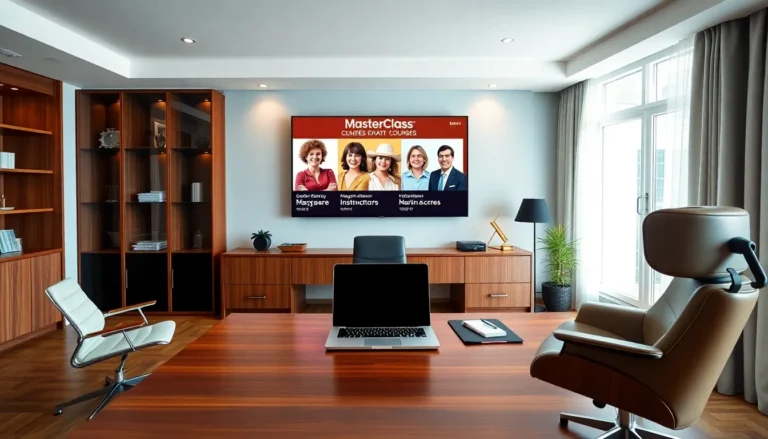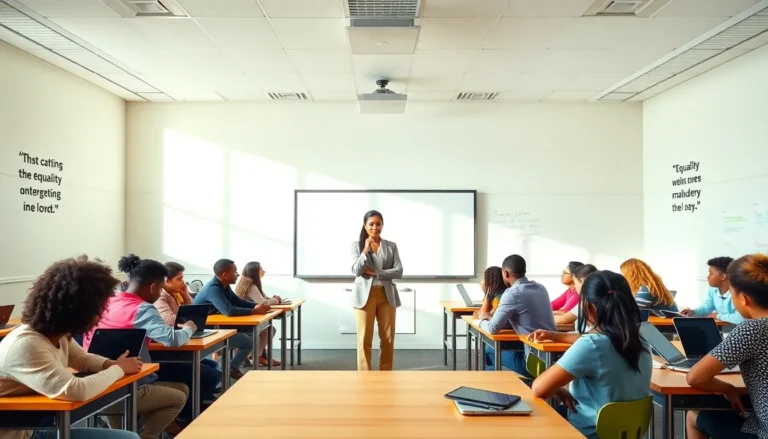In a world where learning often feels like a chore, the design of the learning environment can make all the difference. Imagine stepping into a space that sparks creativity, fosters collaboration, and makes you want to learn instead of binge-watching another season of your favorite show. Learning environment design isn’t just about aesthetics; it’s about crafting spaces that motivate and inspire.
From cozy corners perfect for brainstorming to open areas that encourage teamwork, the right environment can transform how knowledge is absorbed. It’s time to ditch the dull classrooms and embrace innovative designs that make learning as engaging as your favorite video game. Join the journey to discover how a well-designed space can turn even the most reluctant learner into an enthusiastic participant. After all, who wouldn’t want to learn in a place that feels more like a playground than a prison?
Table of Contents
ToggleUnderstanding Learning Environment Design
Learning environment design significantly influences motivation and engagement in educational settings. It fosters creativity and collaboration by moving away from traditional classroom structures and enhancing the overall learning experience.
Definition and Importance
Learning environment design refers to the intentional creation of spaces that facilitate effective teaching and learning. This design encompasses physical, social, and psychological elements. An engaging environment can boost student motivation and commitment. Students perform better in dynamic spaces that inspire creativity. Integrating various design principles enhances collaboration among learners and support from educators. Creating a stimulating atmosphere transforms education into an enjoyable journey matching the excitement of gaming rather than monotonous tasks.
Key Elements of Learning Environments
Several key elements contribute to effective learning environments. Flexible seating arrangements cater to diverse learning styles, allowing students to choose how they engage with content. Natural light enhances well-being and focus, creating a positive ambiance. Technology integration supports interactive learning experiences by utilizing digital tools. Collaborative spaces encourage group work, fostering communication skills and teamwork. Aesthetically pleasing designs capture student interest while motivating exploration and discovery. Each of these elements plays a vital role in shaping an engaging learning experience.
Types of Learning Environments
Understanding various types of learning environments helps educators design more effective spaces. Each type serves distinct purposes and caters to different learning styles.
Traditional Learning Spaces
Traditional learning spaces typically consist of rows of desks facing a teacher’s desk. These environments emphasize lecture-based instruction, limiting student interaction. Chalkboards or whiteboards often serve as the primary tools for information delivery. Standard classroom layouts can inhibit creativity and engagement, making it crucial to consider alternative designs. With an over-reliance on direct instruction, many learners find it difficult to stay motivated in these settings.
Virtual Learning Environments
Virtual learning environments leverage technology to create engaging online educational experiences. Learners access course materials, participate in discussions, and complete assignments from various locations. Interactive elements such as videos, quizzes, and discussion forums enhance user experience. These spaces adjust to individual pacing and learning preferences. Users engage with a global community, gaining diverse perspectives. Flexibility in scheduling allows students to balance education with other responsibilities effectively.
Hybrid Learning Models
Hybrid learning models combine in-person and online instruction, offering flexibility and adaptability. Educators utilize face-to-face classes alongside digital platforms to cater to diverse learning needs. This approach fosters a dynamic environment, as students engage with peers both physically and virtually. Hybrid models benefit from the best of both worlds, allowing for personalized learning experiences. An emphasis on collaboration encourages active participation, enhancing overall learning outcomes. Team projects and discussions thrive within this versatile framework.
Principles of Effective Learning Environment Design
Effective learning environments hinge on specific principles that enhance student experiences. Focusing on the following aspects ensures a vibrant educational atmosphere.
Engagement and Motivation
Creating spaces that promote engagement enhances student motivation. Students thrive in environments filled with stimulating visuals and interactive elements. Integrating technology, such as smart boards and interactive apps, captivates attention and encourages active participation. Incorporating elements like cozy reading nooks and game-based learning stations also sparks curiosity. The presence of natural light further elevates mood, making the environment more inviting. When students feel excited about their surroundings, they are more likely to invest in their learning journey.
Flexibility and Accessibility
Flexibility is crucial for accommodating diverse learning preferences. Varied seating arrangements, like movable furniture, allow students to choose setups that suit their needs. Such adaptability promotes comfort and fosters independence in learning. Accessibility also plays a significant role in design, ensuring that all students can easily navigate the space. Implementing features like adjustable desks and quiet zones supports different learning styles. Environments that embrace flexibility and accessibility create inclusive spaces for all learners.
Collaboration and Interaction
Collaborative spaces encourage interaction, enhancing communication among students. Group work areas foster teamwork and inspire idea sharing. Features like collaborative technology tools facilitate group projects and instant feedback. Open layouts further enhance accessibility, allowing easy movement between areas. When students engage with peers, they develop essential social skills and learn to appreciate diverse perspectives. Design choices that prioritize collaboration significantly boost overall learning outcomes.
Technology’s Role in Learning Environment Design
Technology plays a vital role in shaping modern learning environments. It enhances the educational experience through dynamic interaction and resource availability.
Digital Tools and Resources
Digital tools and resources provide essential support for students and educators. Platforms like learning management systems streamline course delivery and content access. Interactive applications foster engagement by allowing students to participate actively. These resources facilitate differentiation, catering to varying learning styles while creating personalized educational experiences. Furthermore, access to multimedia content enriches lessons, making information more accessible and memorable.
Virtual Reality and Simulations
Virtual reality immerses students in unique educational experiences. These simulations allow learners to explore environments and scenarios that would otherwise be impossible. For instance, virtual field trips transport students to historical sites or distant planets, enriching their understanding of complex topics. Applications in disciplines such as science and history enhance comprehension through experiential learning. This technology inspires creativity and innovation, encouraging collaborative problem-solving among students. By using virtual reality, educators can capture attention and provide unforgettable learning moments.
Case Studies in Learning Environment Design
Case studies illustrate the transformative effects of effective learning environment design. They provide insights into successful implementations and lessons learned from failures.
Successful Implementations
Innovative schools have redesigned classrooms to enhance collaboration and creativity. Flexible seating arrangements encourage group work and foster student engagement. For example, a school in Virginia used movable furniture to adapt spaces for different activities, resulting in a 30% increase in student participation. Integrating technology further supports interactive learning experiences. One California institution reported that adding smartboards led to improved student performance and satisfaction. These implementations showcase how intentional design can positively influence academic outcomes.
Lessons Learned from Failures
Some projects reveal pitfalls in learning environment design. A school in New York invested heavily in a cutting-edge technology lab yet saw limited usage due to unclear objectives. Teachers struggled to incorporate the new space into their curriculum effectively. A Michigan district found that a poorly designed teacher collaboration area hindered communication rather than facilitating it. Feedback from educators indicated that spaces must align with teaching strategies for optimal effectiveness. These examples highlight the necessity of thoughtful planning and continuous evaluation in creating impactful learning environments.
The design of learning environments plays a crucial role in shaping educational experiences. By prioritizing engagement and collaboration, educators can create spaces that not only inspire creativity but also foster a sense of community among students. Incorporating flexible layouts and technology enhances accessibility and encourages active participation.
The shift from traditional classrooms to innovative learning spaces reflects a growing understanding of diverse learning needs. As schools and institutions embrace these principles, they pave the way for more effective teaching methods and improved student outcomes. Ultimately, investing in thoughtful learning environment design is essential for cultivating a generation of motivated and engaged learners.



